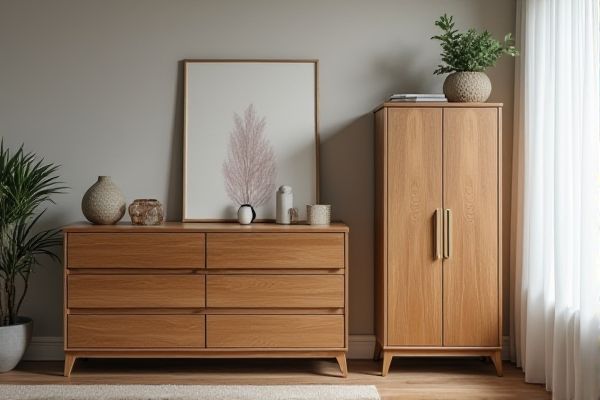
A tallboy offers increased vertical storage with multiple drawers stacked high, ideal for maximizing space in smaller rooms, whereas a lowboy provides a wider, lower profile suited for larger spaces and often doubles as a vanity or TV stand. Discover which style best fits Your needs by exploring the detailed comparison ahead.
Table of Comparison
| Feature | Tallboy | Lowboy |
|---|---|---|
| Height | Typically 60-80 inches tall | Usually 30-36 inches tall |
| Design | Vertical, multiple stacked drawers | Horizontal, wide with fewer drawers |
| Storage Capacity | High, utilizes vertical space | Moderate, prioritizes surface area |
| Usage | Ideal for small rooms and maximizing vertical space | Commonly used as nightstands or under windows |
| Mobility | Less stable due to height, often stationary | Stable and easier to move |
| Material | Wood, metal, or composite | Wood, metal, or composite |
| Price Range | Varies widely; often mid to high range | Generally affordable, mid-range pricing |
Introduction to Tallboy and Lowboy
Tallboy and Lowboy are two common types of furniture designed for storage, each with distinct shapes and uses. A Tallboy is a vertical chest of drawers typically standing over five feet tall, maximizing storage space in a compact footprint. Lowboy, by contrast, is a shorter, wide chest designed to be used as a dressing table or additional storage surface, often complementing bedroom or living room decor.
Historical Background of Tallboys and Lowboys
Tallboys and lowboys originated in colonial America, with tallboys designed as elevated chest-of-drawers atop a standalone base to save space and provide storage. Lowboys emerged as smaller, waist-high dressing tables or desks, reflecting the 18th-century demand for functional yet elegant bedroom furniture. Your choice can connect you to this rich history of furniture evolution, blending practicality with traditional craftsmanship.
Defining Features: Tallboy vs Lowboy
Tallboys are high chest-of-drawers featuring multiple vertically stacked drawers, typically ranging from five to seven, designed to maximize storage in compact floor spaces. Lowboys are shorter, wider dressers with two to three rows of drawers, prioritizing horizontal storage surface ideal for placing accessories or decorative items. The primary distinction lies in their height-to-width ratio, where tallboys emphasize vertical space efficiency while lowboys provide extensive tabletop area and broader drawer dimensions.
Common Materials and Construction
Tallboys and lowboys commonly utilize durable hardwoods such as oak, maple, and cherry for their robust construction and appealing grain patterns. The frames are typically crafted with solid wood for strength, while drawer bottoms and backs often feature plywood or MDF for added stability and cost-efficiency. Joinery techniques like dovetail joints are frequently employed in both furniture types to ensure long-lasting drawer durability and structural integrity.
Storage Capacity and Functionality
Tallboy furniture offers increased vertical storage capacity, making it ideal for storing clothing and accessories in multiple drawers without occupying much floor space. Lowboy designs provide wider drawer dimensions for bulkier items, enhancing accessibility and functionality in smaller rooms or under windows. Optimal choice depends on the balance between spatial constraints and the type of items intended for storage.
Style and Design Differences
Tallboys feature a vertical design with multiple stacked drawers, maximizing storage while occupying minimal floor space, often showcasing sleek lines and a modern aesthetic. Lowboys have a wider, horizontal layout with fewer, larger drawers, emphasizing a broad surface area and a more traditional or retro style. The contrast in proportions influences room dynamics, with tallboys adding height and lowboys enhancing width visually.
Placement and Space Considerations
Tallboys optimize vertical space, making them ideal for smaller rooms or areas with limited floor space. Lowboys provide a wider surface area and fit well under windows or sloped ceilings, maximizing horizontal space. Your choice depends on the room's layout and whether vertical height or horizontal spread is more important for placement.
Popular Uses in Modern Interiors
Tallboy dressers are popular in modern bedrooms for maximizing vertical storage without occupying much floor space, ideal for smaller rooms or apartments. Lowboy dressers complement contemporary living rooms or bedrooms by offering wide drawer space perfect for clothing or media organization, often doubling as TV stands or display surfaces. Your choice depends on the available space and the specific storage needs you want to address in your interior design.
Maintenance and Care Tips
Tallboy and lowboy furniture require regular dusting and polishing to maintain their finish and prevent surface damage. Pay special attention to drawer mechanisms; lubricate runners and hinges periodically to ensure smooth operation and reduce wear. Your careful maintenance prolongs the lifespan of both tallboy's vertical structure and lowboy's horizontal design, keeping them functional and attractive for years.
Choosing Between Tallboy and Lowboy
Choosing between a tallboy and lowboy depends on your storage needs and space constraints. A tallboy offers multiple vertically stacked drawers, maximizing storage in smaller floor areas, while a lowboy provides wider, more accessible drawers ideal for larger items or workspace integration. Assess your room layout and the type of items you plan to store to determine which furniture piece best suits your organization and aesthetic preferences.
 homyna.com
homyna.com